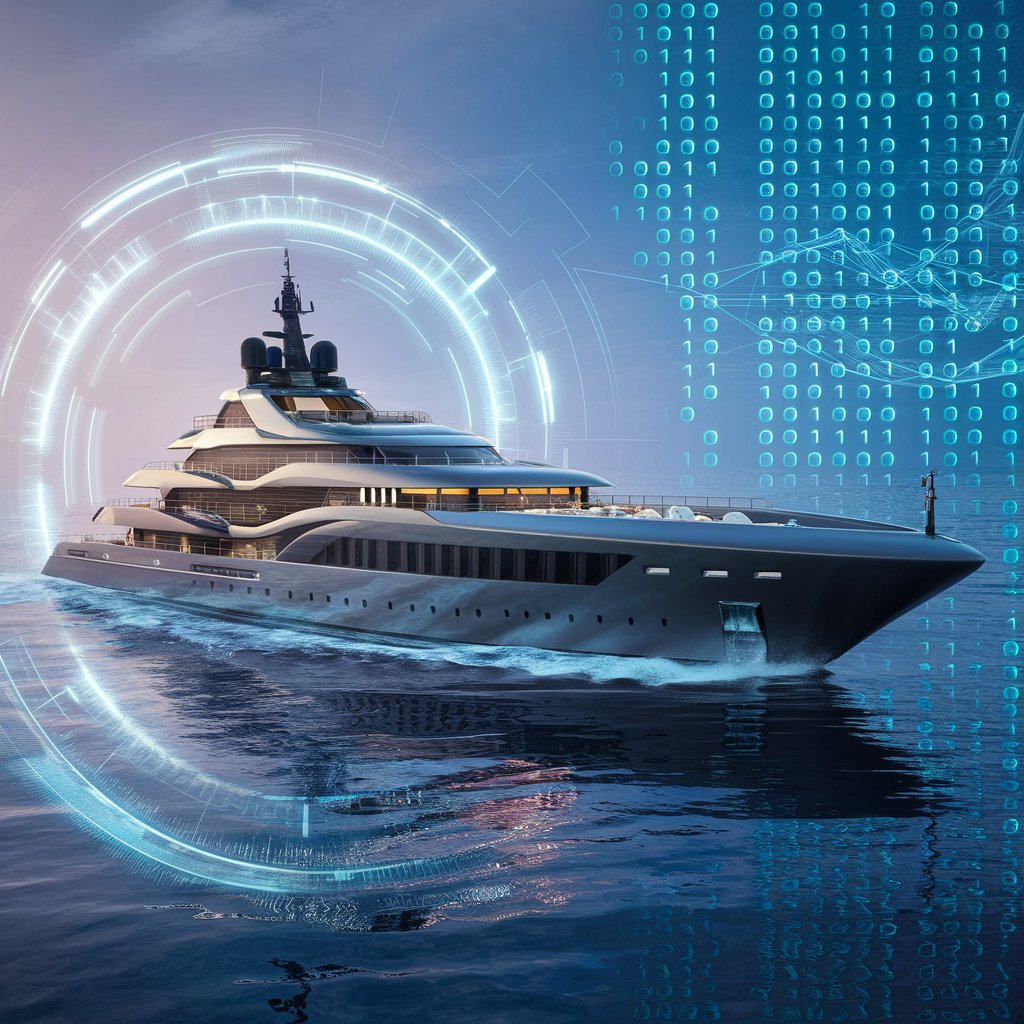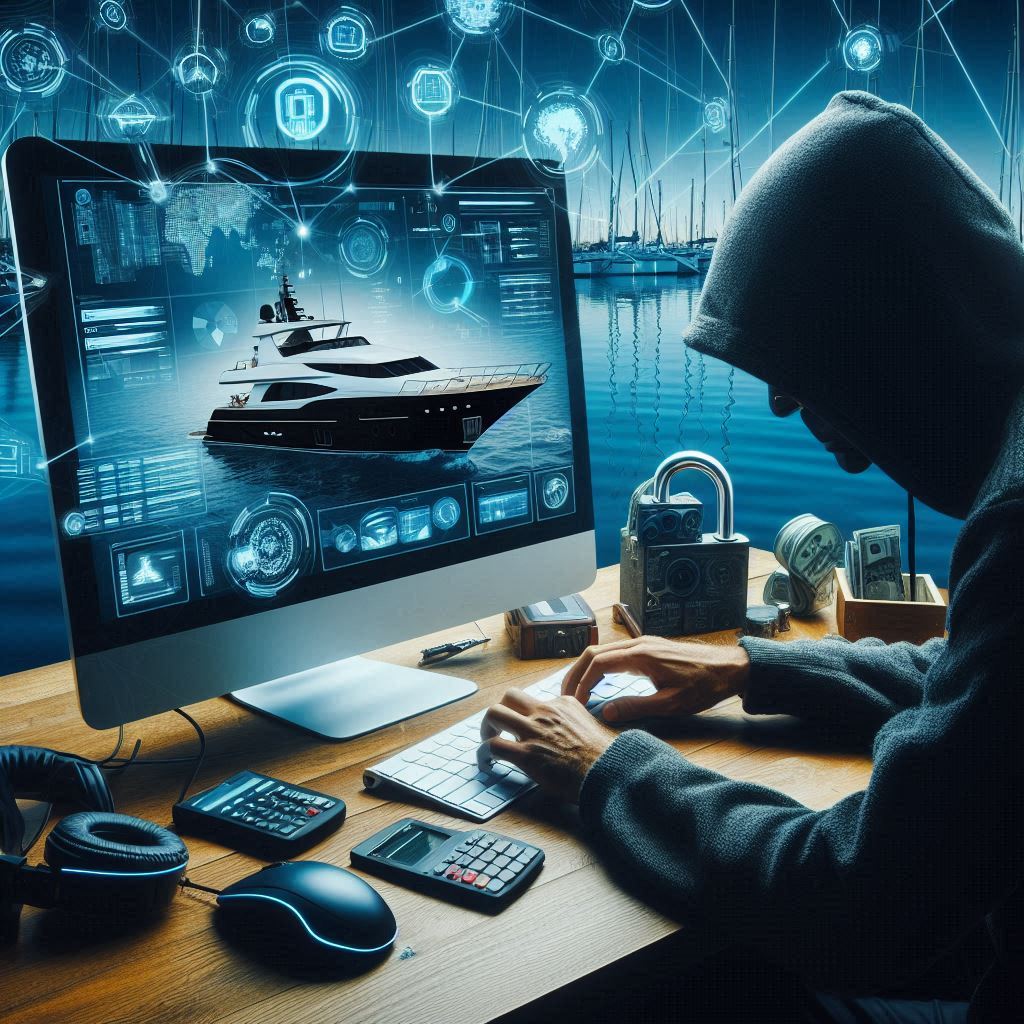I embark on this article to shed light on an issue that has grown in significance alongside the advancements in Yacht Technology. Modern yachts have transformed from simple sea vessels to highly interconnected hubs brimming with state-of-the-art tech. If you own a yacht or are part of its Operational Crew, understanding the interconnected systems onboard is crucial.
Imagine a scenario where a hacker gains access to a yacht’s navigation system. The potential consequences could range from relatively minor inconveniences to severe, life-threatening situations. Cyber attackers could manipulate the yacht’s course, disable essential systems, or even access personal data of the yacht’s occupants. Given these risks, it is imperative that yacht owners and operators prioritize cybersecurity to safeguard their vessels and the people on board.

Now while specific incidents involving yachts may not always be publicized due to the privacy concerns of the wealthy individuals who own them, there have been several reported instances where cybersecurity breaches have affected high-profile yachts.
- The Superyacht “Lionheart” (2018): Owned by British retail tycoon Sir Philip Green, the 90-meter superyacht Lionheart reportedly faced a cyber attack in 2018. Hackers attempted to gain access to the vessel’s navigation systems, potentially putting the crew and guests at significant risk. Fortunately, the crew’s prompt action and existing cybersecurity measures managed to thwart the attack before any major damage could be done. This incident highlighted the vulnerability of even the most luxurious and technologically advanced yachts.
- The Mega Yacht “SeaDream I” (2020): The SeaDream I, a luxury mega yacht operated by SeaDream Yacht Club, experienced a significant cybersecurity incident in 2020. Hackers targeted the vessel’s IT systems, leading to a temporary disruption of onboard services and communications. This attack underscored the importance of having robust cybersecurity protocols in place, as the interruption affected the guest experience and operational efficiency.
- Unnamed 100-meter Superyacht (2019): In another notable case, an unnamed 100-meter superyacht suffered a ransomware attack in 2019. The attackers encrypted the yacht’s critical systems, demanding a ransom to restore functionality. The incident caused a complete shutdown of the yacht’s operational systems, leaving it immobilized until the crew could secure assistance from cybersecurity experts. This event emphasized the necessity for advanced cybersecurity measures and regular training for the crew to handle such scenarios effectively.
Nordpass is a secure and user-friendly password manager designed to help you store, manage, and access your passwords effortlessly. With robust encryption and seamless synchronization across devices, Nordpass ensures your sensitive information is always protected and easily accessible. It also features password generation and autofill capabilities, making it simple to enhance your online security.
Click on the photo below for more information.
These examples demonstrate that cyber threats are a real and pressing concern for the yachting industry. A yacht today is far more than a mode of sea travel. Sophisticated Navigation Systems, satellite communications, and a variety of IoT devices contribute to a seamless and luxurious maritime experience. However, where there is connectivity, there is potential for infiltration.
To counter this, cybersecurity must take a front seat in the operational protocol of yachts, a non-negotiable aspect in the checklist of maritime safety. It’s a vital shield that protects not just the technological infrastructures but also the people who enjoy the Waves and Winds of the open seas.
Steering Through Cyber Threats: Strategies for Yacht Cybersecurity
To navigate these needs effectively, here are some key Consideration for Yacht Cybersecurity:
- Comprehensive Security Assessment: Conduct thorough evaluations of all onboard systems to identify vulnerabilities.
- Network Segmentation: Separate critical systems from non-essential networks to limit the impact of a potential breach.
- Regular Software Updates: Ensure all software, including navigation and communication systems, is up-to-date to protect against known vulnerabilities.
- Strong Password Policies: Implement robust password policies, including the use of multi-factor authentication, to enhance security.
- Crew Training: Educate crew members on cybersecurity best practices to prevent accidental breaches.
- Incident Response Plan: Develop and regularly update an incident response plan to quickly address any security incidents.
A vigilant stance against cyber dangers is essential. Staying apprised of the latest cyber threats and keeping security measures current is much like charting a course in familiar waters – it requires constant monitoring and adjustment.
Empowered by these robust security strategies, yacht Captains can cruise with confidence. It’s this preparedness that transforms the risk-ridden digital waves into navigable waters, assuring safe and secure voyages for all onboard.
Actionable Steps for Enhancing Yacht Cybersecurity:
- Perform regular cybersecurity audits to identify and mitigate potential vulnerabilities.
- Install firewalls and intrusion detection systems to monitor and protect network traffic.
- Use encrypted communication channels to safeguard sensitive data.
- Limit access to critical systems to authorized personnel only.
- Stay informed about emerging cyber threats and adjust security measures accordingly.
- Collaborate with cybersecurity experts to develop and implement tailored security strategies.
Standards for Maritime Cybersecurity: Navigating Compliance
As the maritime industry becomes increasingly digitalized, standards for cybersecurity have emerged to ensure the safety and integrity of vessels, including Yachts. The International Maritime Organization (IMO) plays a pivotal role in setting these standards. In 2017, the IMO adopted Resolution MSC.428(98), which mandates that maritime cyber risks be addressed in safety management systems by 2021. This resolution requires shipowners and operators to develop and implement cybersecurity policies and procedures tailored to their specific operations.
These policies must cover various aspects, including risk management, incident response, and contingency planning. By adhering to IMO guidelines, the maritime industry aims to create a robust framework that mitigates cyber threats and ensures the safe operation of vessels. In addition to IMO standards, the maritime industry also looks to the National Institute of Standards and Technology (NIST) Cybersecurity Framework and the International Organization for Standardization (ISO) for guidance.

The NIST framework provides a comprehensive set of best practices for managing cybersecurity risks, emphasizing the importance of identifying, protecting, detecting, responding to, and recovering from cyber incidents. Similarly, ISO/IEC 27001 sets out the criteria for establishing, implementing, maintaining, and continuously improving an information security management system (ISMS).
For yacht owners and operators, aligning with these frameworks helps ensure a high level of cybersecurity. It also demonstrates a commitment to protecting critical systems and sensitive information, thereby enhancing trust and safety within the maritime community.
What are the Different Stages of Cyber-Attacks and what Threats do They Pose?

Cyber attacks on vessels typically unfold in several distinct stages, each posing unique threats to the vessel’s operations and safety. The first stage, reconnaissance, involves cyber attackers gathering information about the vessel’s systems, networks, and potential vulnerabilities.
During this phase, hackers might identify weak points in the ship’s communication systems, navigation equipment, or even crew members’ devices. The threat at this stage is primarily the unauthorized access to sensitive information, which can be used to plan more targeted and effective attacks. For instance, discovering an unpatched software vulnerability or unsecured network access point can provide a foothold for the attacker to move to the next stage.
Following reconnaissance, the second stage, initial compromise, sees the attackers exploiting identified vulnerabilities to gain entry into the vessel’s systems. This could involve deploying malware, phishing attacks targeting the crew, or exploiting software flaws. Once inside, the attacker can escalate privileges and move laterally through the network in the exploitation and installation stages, allowing them to gain control over more critical systems.

This is where the threats become more pronounced and dangerous. An attacker could manipulate navigation data, disable communication systems, or interfere with engine controls, leading to potentially disastrous situations such as misrouting, collisions, or engine failures. Additionally, attackers might exfiltrate sensitive data, such as passenger information or proprietary ship data, posing privacy and security risks.
The final stages, command and control and exfiltration, involve the attacker maintaining control over the compromised systems and extracting valuable data or causing further disruptions, highlighting the need for robust cybersecurity defenses to detect and mitigate these threats early in the attack lifecycle.
How Does Cyber Security Help the Maritime Industry?

Cybersecurity plays a crucial role in enhancing the safety and efficiency of the maritime industry. By protecting critical systems from cyber threats, cybersecurity measures ensure that navigation, communication, and control systems operate without interruption.
This is vital for preventing potentially catastrophic incidents, such as collisions or groundings, which can occur if these systems are compromised. For instance, a well-implemented cybersecurity strategy can thwart attempts to hijack a vessel’s navigation system, preventing malicious actors from altering a ship’s course or causing it to enter dangerous waters. Additionally, safeguarding communication channels ensures that crew members can maintain constant, secure contact with onshore personnel like the yacht’s Agent or Broker and other vessels, which is essential for coordinated operations and emergency response.
Beyond safety, cybersecurity also significantly enhances operational efficiency within the maritime industry. Protecting data integrity and availability allows for seamless logistics and supply chain management, which is critical in an industry where timing and precision are paramount.

Secure systems enable the reliable transfer of data related to cargo, fuel consumption, and maintenance schedules, facilitating better decision-making and resource management. For example, by preventing data breaches and ensuring that all information remains accurate and accessible, cybersecurity measures help optimize routing, reduce fuel costs, and improve overall operational efficiency.
This not only enhances the profitability of maritime operations but also contributes to sustainability efforts by minimizing waste and reducing the carbon footprint of shipping activities. In essence, robust cybersecurity is foundational to the modern maritime industry, supporting both its safety and its economic viability.

Crew members on yachts play a critical role in ensuring onboard security by implementing and adhering to comprehensive cybersecurity measures. This includes conducting regular security assessments, maintaining strong password policies, and staying informed about emerging cyber threats. Yachts frequently navigate through various regions and countries, making it crucial for crew members to implement robust cybersecurity strategies to protect their online activities from cyberattacks. Ensuring secure internet use is essential for safeguarding both personal and vessel-related information.
Crew members add to this cyber awareness by fostering a culture of vigilance and proactive behavior. They should be trained to recognize and report suspicious activities, such as unauthorized access attempts or unusual network traffic. Regular drills and training sessions can help reinforce best practices, such as verifying the authenticity of emails and attachments before opening them, using strong, unique passwords for all accounts, and ensuring that software and systems are up to date with the latest security patches.
Additionally, crew members should enforce policies that restrict guests from connecting unknown devices to the yacht’s network and educate them on the dangers of clicking on suspicious links while using onboard Wi-Fi. By staying vigilant and informed, crew members can significantly reduce the risk of cybersecurity breaches, ensuring the yacht’s systems and location remain secure.
Of course, staying connected securely across various international waters is essential, and using a Reliable and Secured Online Service is critical to ensuring the safety of all online activities for crew members for both their personal and professional activities.

Conclusion
As yachts continue to integrate Advanced Technologies and digital systems, the importance of robust cybersecurity cannot be overstated. The incidents involving high-profile yachts like Lionheart, SeaDream I, and other unnamed vessels illustrate the real and evolving threats posed by cyber attacks. These breaches not only jeopardize the safety and privacy of those on board but also disrupt operations and incur significant financial costs.
It is imperative for yacht owners, operators, and the maritime industry as a whole to adopt comprehensive cybersecurity measures. By doing so, they can safeguard against cyber threats and ensure that these luxurious vessels remain secure as they navigate the increasingly digital waters of the modern world.
**Our Website contains affiliate links. This means if you click and make a purchase, we may receive a small commission. Don’t worry, there is no extra cost to you. It’s a simple way you can support our mission to bring you quality content**.



Wow. Another downside of this digital age in which we currently live. Never have I thought about cyber breaches in yachting. Such a scary thought!
This is a very informative blog. You have laid out some pretty important information regarding cybersecurity and its importance. I am intrigued by the possibility of unreported or unknown cases of breaches.
Hey Dee
Many thanks for your thoughtful comments. I am delighted that you found the blog informative.
Highlighting the importance of cybersecurity for a yacht is crucial in today’s digital age where technology plays a significant role in maritime operations. Yachts are increasingly interconnected with various systems and devices, making them vulnerable to cyber threats. Ensuring robust cybersecurity measures onboard is essential to protect sensitive data, prevent unauthorized access, and safeguard the vessel against potential cyber attacks. Implementing firewalls, encryption protocols, regular security audits, and employee training can significantly mitigate risks.
Hello Elias
Many thanks for your thoughtful feedback. I am delighted you enjoyed the article.
Hi Troy,
Thanks for sharing this great article!
This article really nails the growing importance of cybersecurity in the yachting world. With yachts becoming more advanced and interconnected, the potential for cyber attacks is a serious concern. I was particularly struck by the examples of the “Lionheart,” “SeaDream I,” and the unnamed superyacht incidents. These stories show that even the most luxurious and tech-savvy yachts aren’t immune to cyber threats.
The thought of hackers gaining control of a yacht’s navigation system or accessing personal data is pretty alarming. It’s clear that yacht owners and operators need to prioritize cybersecurity just as much as they do traditional maritime safety.
In short, this article is a must-read for anyone in the yachting industry. It highlights the need for vigilance and proactive measures to safeguard against cyber threats. As yachts continue to embrace new technologies, ensuring cybersecurity will be key to safe and enjoyable voyages.
Hello Kavitha
Many thanks, I am delighted that you enjoyed the article.
Hi Troy,
Such a great article. Your article on cybersecurity in yachting is both enlightening and timely. It’s fascinating to see how digital security intersects with maritime adventures. It made me wonder:
What are some of the most common cybersecurity threats that yacht owners face today?
How can crew members be effectively trained to recognize and respond to these threats?
Additionally, have specific cybersecurity technologies or practices proven particularly effective in safeguarding yachts?
I’d love to hear more about your experiences and recommendations on navigating these digital waters safely.
Very well done.
Hi Sara
Thank you for your positive feedback on my article about cybersecurity in yachting! I’m glad you found it enlightening. Yacht owners today commonly face threats like phishing attacks, ransomware, and GPS spoofing.
Crew members can be effectively trained through regular cybersecurity awareness programs, simulated attack drills, and clear protocols for reporting suspicious activities. Technologies like intrusion detection systems, encrypted communication tools, and multi-factor authentication have proven particularly effective in safeguarding yachts.
I appreciate your interest and look forward to sharing more insights on navigating these digital waters safely.
Hello Troy,
Another gold nugget for the yacht enthusiasts, I had no idea of the importance of cybersecurity in the yachting industry and how vulnerable this industry was to cyber attacks.
Thanks God for The International Maritime Organization (IMO), the National Institute of Standards and Technology (NIST), and the International Organization for Standardization (ISO) provide standards and frameworks for managing cybersecurity risks in the maritime industry.
One thing I know for sure when it come to cybersecurity;
Cybersecurity is not just about technology; it’s also about people and their behaviors.
Everyone on board has a role to play in maintaining cybersecurity. For instance, guests should be made aware of the risks of connecting unknown devices to the yacht’s systems or clicking on suspicious links while using the yacht’s Wi-Fi.
Because let face it, International water are lawless and depending of the area the yacht is cruising keeping your location from intruder or preying eyes is a must.
One question come to mind after reading your post;
How do international organizations like the IMO, NIST, and ISO contribute to managing cybersecurity risks in the maritime industry and which area seem to be more problematic?
Thanks for sharing your knowledge and experience.
All the best,
Eric
Hey Eric
Thank you for your insightful feedback! It’s great to see your recognition of the importance of cybersecurity in the yachting industry and the role everyone plays in maintaining it. International organizations like the IMO, NIST, and ISO provide crucial frameworks and standards for managing cybersecurity risks by establishing guidelines for secure operations, risk management, and incident response.
They contribute to creating a unified approach to cybersecurity across the industry, enhancing overall safety. The most problematic areas often include securing communication systems, safeguarding navigation equipment, and protecting personal data of guests and crew members from cyber threats.
Thanks again